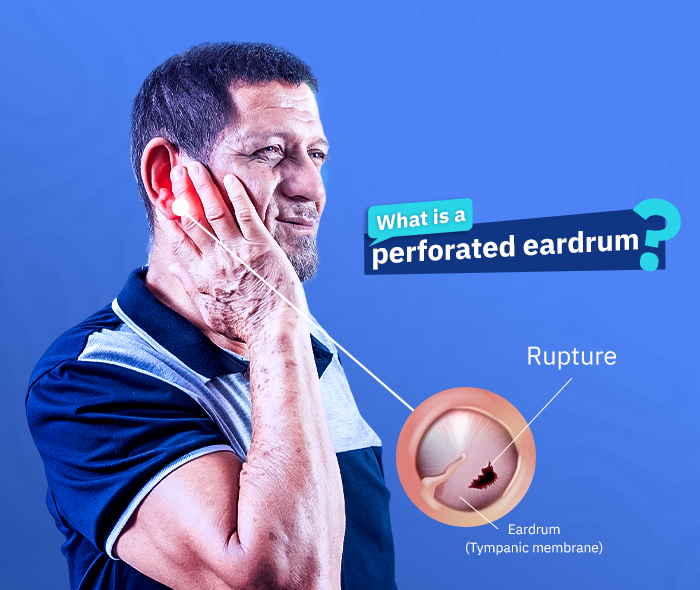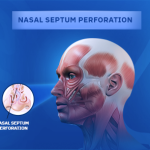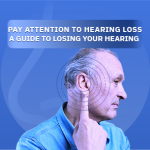ruptured eardrum
Have you ever felt a sudden pain in your ear or noticed an unusual discharge coming from it? These could be signs of a ruptured eardrum, a condition that affects many people around the world. The eardrum is a very thin, semi-transparent membrane that separates the outer ear from the middle ear. Its primary function is to transmit sound: it vibrates when sound waves reach it from the outside and converts these vibrations into signals for the middle ear.
Additionally, the eardrum acts as a barrier that prevents foreign objects and bacteria from entering the middle ear, making it the first line of defense for the middle ear. Therefore, it plays a vital role in normal hearing.
In this article, we will shed light on everything related to a ruptured eardrum and how to manage it properly.
- What is a ruptured eardrum?
- Causes of eardrum perforation
- Symptoms of a ruptured eardrum
- Diagnosis of eardrum perforation
- Complications of a ruptured eardrum
- Treatment for a ruptured eardrum
- Prevention methods for eardrum perforation
- Can you live normally with a ruptured eardrum?

What is a ruptured eardrum?
A ruptured eardrum is a common medical condition that occurs when the thin membrane separating the outer ear from the middle ear is torn, this can happen due to several factors such as infections, direct injury, or sudden changes in pressure, aperforation in the eardrum can lead to hearing problems and pain, and in some cases, it may require medical treatment to prevent complications.
Causes of eardrum perforation
There are various causes that can lead to a perforated eardrum, and the most common include:
Middle ear infection (Otitis Media):
When a bacterial or viral infection affects the middle ear, fluid and pus can build up inside the ear cavity, this accumulation increases pressure behind the eardrum, potentially causing it to rupture, such infections may also lead to temporary hearing difficulties.
Insertion of foreign objects into the ear:
This is especially common among children, who may insert objects like cotton swabs, pencils, or small toys into their ears, these objects can scratch the ear canal or directly tear the eardrum, resulting in sharp pain, light bleeding, or temporary hearing loss.
Exposure to loud noises:
Sudden loud sounds such as fireworks, explosions, or even loud music through headphones or at concerts can cause a rupture due to intense sound waves exerting pressure on the inner ear. This may be accompanied by symptoms like ringing in the ear (tinnitus), temporary or permanent hearing loss, and dizziness.
Severe blows to the head:
Head trauma from car accidents, falls from height, or direct strikes to the ear can lead to skull fractures or damage to the middle ear. In many cases, a ruptured eardrum may occur alongside more serious injuries, such as ear bleeding or a concussion.
Barotrauma (Pressure Trauma):
This occurs when there’s an abnormal and unstable pressure difference between the middle ear and the external environment, a significant pressure change can cause the eardrum to rupture. Barotrauma is commonly experienced during air travel, scuba diving, or after a direct blow to the ear.
Incorrect or unsafe medical procedures:
Certain medical interventions may unintentionally cause eardrum perforation, examples include improper ear cleaning, inserting instruments too deeply during an exam or surgery, or misusing ear drops, especially if a pre-existing perforation is present—leading to worsening of the condition.
Symptoms of a ruptured eardrum
In some cases, a ruptured eardrum may occur without any noticeable symptoms at first. However, there are certain signs that can indicate an issue in the ear and should not be ignored, here are the most common symptoms:
Ear pain:
One of the most frequent symptoms, ear pain may be sudden or sharp, like a stabbing sensation, interestingly, the pain often lessens or disappears after the eardrum ruptures.
Ear discharge:
You might notice fluid draining from the ear, ranging from white or yellow pus to fluid mixed with blood, this is a common sign of a torn eardrum.
Tinnitus (Ringing in the ear):
The affected person may hear a constant or intermittent ringing, buzzing, or other internal noise that is not caused by an external source.
Dizziness or balance issues:
A ruptured eardrum can cause a sensation of dizziness or imbalance, sometimes accompanied by nausea or even vomiting.
Itching or irritation in the ear:
The person may feel an urge to scratch inside the ear due to irritation, often caused by fluid leakage or infections related to the eardrum tear, this irritation can lead to a feeling of discomfort or persistent annoyance inside the ear canal.
Fever:
If the rupture is caused by an infection or inflammation, the body may respond with a mild fever as a natural immune reaction, this is an important sign of an active infection that may require treatment.
Temporary or sudden hearing loss:
One of the direct consequences of a perforated eardrum is a drop in hearing ability, damage to the eardrum interferes with the transmission of sound waves to the middle ear, resulting in muffled or diminished hearing.

Diagnosis of eardrum perforation
Diagnosing a ruptured eardrum involves a series of examinations and procedures conducted by an ear, nose, and throat (ENT) specialist to accurately identify the presence, size, and location of the perforation, the most commonly used diagnostic methods include:
Otoscope examination:
This is typically one of the first diagnostic steps, the doctor uses a lighted instrument called an otoscope to clearly view the external ear canal and the eardrum. This allows for the detection of any tears or perforations in the eardrum, as well as signs of infection or discharge.
Tuning fork test:
This test is used to determine the nature of hearing loss, whether it is caused by a problem in the middle ear, such as a ruptured eardrum, or due to issues in the inner ear or auditory nerves, the physician places a vibrating tuning fork on specific parts of the head and ear to assess the source of the hearing impairment.
Hearing test (Audiometry):
This test assesses the patient’s hearing ability and determines how much it has been affected by the eardrum perforation, the test exposes the ear to sounds at various frequencies and volumes to measure the response, a related test, known as tympanometry, may also be performed to evaluate the mobility and flexibility of the eardrum.
Imaging (when necessary):
In rare or complex cases, the doctor may order imaging, such as a CT scan, to examine the middle ear and surrounding structures. This is particularly useful when chronic infections or complications are suspected.
Tympanometry (Middle ear pressure test):
This test measures how the eardrum responds to slight changes in air pressure within the ear canal, abnormal patterns of eardrum movement revealed by this test often indicate the presence of a perforation or tear.
Complications of a ruptured eardrum
If the eardrum is torn and does not heal on its own within a period of 3 to 6 months, certain uncommon but potentially serious complications may arise, including:
Hearing loss:
Hearing loss is often temporary and usually improves once the eardrum heals, however, the severity of hearing impairment depends on the size and location of the perforation.
Middle ear infections (Otitis Media):
A hole in the eardrum can allow bacteria to enter the middle ear, increasing the risk of infection, especially if the eardrum does not heal. In some cases, this may lead to chronic infections accompanied by persistent discharge or even permanent hearing loss.
Cholesteatoma:
This is a rare cyst-like growth made up of skin cells and other debris that can develop in the middle ear, a ruptured eardrum can allow these materials to enter the middle ear cavity, creating an ideal environment for bacterial growth. Cholesteatomas can damage the bones of the ear through the release of destructive enzymes and proteins, potentially leading to more serious complications.
Treatment for a ruptured eardrum
The treatment of a ruptured eardrum depends on the size of the tear and the severity of associated symptoms. In many cases, small perforations heal on their own within a period of two weeks to two months. However, several treatment options may be considered by the doctor:
Topical or oral antibiotics:
These are used to treat or prevent bacterial infections in the middle ear, especially if there is an accompanying infection or an open tear in the eardrum.
Pain relievers:
Pain medications are prescribed to relieve discomfort and pain caused by the tear or infection.
Tympanic membrane patch (Eardrum Patching):
This is a simple surgical procedure in which a small patch is placed over the perforation to encourage healing of the eardrum, this procedure is typically performed on an outpatient basis.
Medications for dizziness:
These may be prescribed if the perforation is accompanied by dizziness or balance disturbances.
Prevention methods for eardrum perforation
Monitor for symptoms of infection:
Watch for signs of infection such as pain, fever, hearing loss, and nasal congestion, especially in children, early consultation with a doctor helps prevent eardrum perforation.
Precautions during air travel:
Changes in air pressure during flight can harm the eardrum, particularly when suffering from a cold or allergies, to reduce the risk, use earplugs, chew gum, or try yawning during the flight.
Avoid cleaning ears with cotton swabs or sharp objects:
Using cotton swabs or sharp tools can cause a tear in the eardrum, limit cleaning to the outer ear, and leave the inner ear cleaning to a doctor, it is also important to teach children the dangers of inserting foreign objects into their ears, as this can lead to infections or serious injuries.
Protection from noise and explosions:
Protect your ears by using earplugs or earmuffs when in noisy environments, avoid standing too close to speakers or areas of explosions such as fireworks. It is also crucial to lower the volume of your headphones when listening to music.
A ruptured eardrum may seem like a minor issue, but it can significantly affect hearing and quality of life if not treated correctly, it doesn’t only lead to hearing loss but may also be accompanied by pain, dizziness, or even chronic infections if neglected, therefore, early diagnosis and closely following medical instructions are crucial steps in both treatment and prevention. If you experience pain, notice changes in your hearing, or see abnormal discharge, seeking medical attention is the best option for you.







